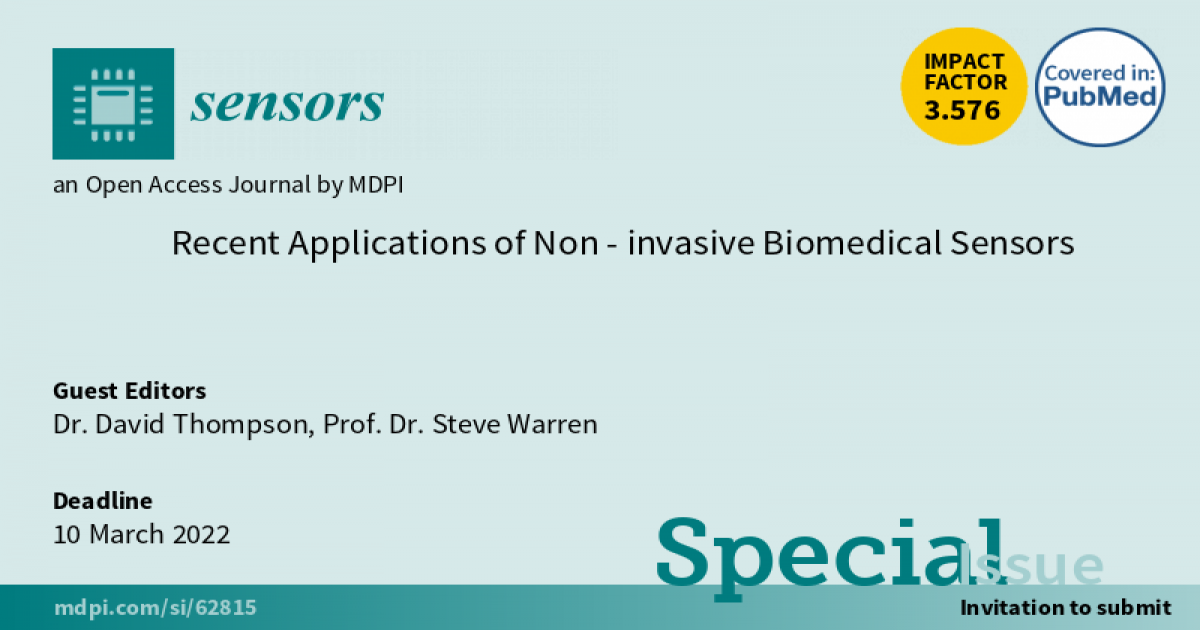Recent Applications of Non-invasive Biomedical Sensors
A special issue of Sensors (ISSN 1424-8220). This special issue belongs to the section "Biomedical Sensors".
Deadline for manuscript submissions: closed (10 March 2022) | Viewed by 18751

Special Issue Editors
Interests: biomedical sensors and applications (PPG, BCG, EEG); performance measurement; affect/emotion estimation; non-invasive and non-contact sensors
Interests: medical interoperability standards; wearable and non invasive sensors; signal processing for health applications; human and animal health; engineering education
Special Issue Information
Dear Colleagues,
The continued development of new sensors and sensing modalities has enabled new biomedical applications including long-term sleep studies, non-contact health monitoring, and measurement of health parameters in animals or human populations that cannot tolerate obtrusive sensors. This Special Issue will focus on new applications as well as enabling technologies, with particular focus on truly non-invasive, non-obtrusive sensors.
Dr. David Thompson
Prof. Dr. Steve Warren
Guest Editors
Manuscript Submission Information
Manuscripts should be submitted online at www.mdpi.com by registering and logging in to this website. Once you are registered, click here to go to the submission form. Manuscripts can be submitted until the deadline. All submissions that pass pre-check are peer-reviewed. Accepted papers will be published continuously in the journal (as soon as accepted) and will be listed together on the special issue website. Research articles, review articles as well as short communications are invited. For planned papers, a title and short abstract (about 250 words) can be sent to the Editorial Office for assessment.
Submitted manuscripts should not have been published previously, nor be under consideration for publication elsewhere (except conference proceedings papers). All manuscripts are thoroughly refereed through a single-blind peer-review process. A guide for authors and other relevant information for submission of manuscripts is available on the Instructions for Authors page. Sensors is an international peer-reviewed open access semimonthly journal published by MDPI.
Please visit the Instructions for Authors page before submitting a manuscript. The Article Processing Charge (APC) for publication in this open access journal is 2600 CHF (Swiss Francs). Submitted papers should be well formatted and use good English. Authors may use MDPI's English editing service prior to publication or during author revisions.
Keywords
- non-invasive sensors
- non-obtrusive sensors
- non-contact sensors
- long-term monitoring
- human health monitoring
- animal health monitoring
- non-compliant populations
Benefits of Publishing in a Special Issue
- Ease of navigation: Grouping papers by topic helps scholars navigate broad scope journals more efficiently.
- Greater discoverability: Special Issues support the reach and impact of scientific research. Articles in Special Issues are more discoverable and cited more frequently.
- Expansion of research network: Special Issues facilitate connections among authors, fostering scientific collaborations.
- External promotion: Articles in Special Issues are often promoted through the journal's social media, increasing their visibility.
- Reprint: MDPI Books provides the opportunity to republish successful Special Issues in book format, both online and in print.
Further information on MDPI's Special Issue policies can be found here.







